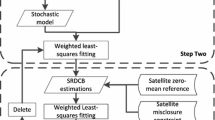Abstract
Differential code biases (DCBs) are important parameters that must be estimated accurately and reliably for high-precision GNSS applications. For optimal operational service performance of the Beidou navigation system (BDS), continuous monitoring and constant quality assessment of the BDS satellite DCBs are crucial. In this study, a global ionospheric model was constructed based on a dual system BDS/GPS combination. Daily BDS DCBs were estimated together with the total electron content from 23 months’ multi-GNSS observations. The stability of the resulting BDS DCB estimates was analyzed in detail. It was found that over a long period, the standard deviations (STDs) for all satellite B1–B2 DCBs were within 0.3 ns (average: 0.19 ns) and for all satellite B1–B3 DCBs, the STDs were within 0.36 ns (average: 0.22 ns). For BDS receivers, the STDs were greater than for the satellites, with most values \(<\)2 ns. The DCBs of different receiver families are different. Comparison of the statistics of the short-term stability of satellite DCBs over different time intervals revealed that the difference in STD between 28- and 7-day intervals was small, with a maximum not exceeding 0.06 ns. In almost all cases, the difference in BDS satellite DCBs between two consecutive days was \(<\)0.8 ns. The main conclusion is that because of the stability of the BDS DCBs, they only require occasional estimation or calibration. Furthermore, the 30-day averaged satellite DCBs can be used reliably for the most demanding BDS applications.







Similar content being viewed by others
References
Choi B, Cho J, Lee S (2011) Estimation and analysis of GPS receiver differential code biases using KGN in Korean Peninsula. Adv Space Res 47:1590–1599
Coco DS, Coker C, Dahlke SR, Clynch JR (1991) Variability of GPS satellite differential group delay biases. IEEE Trans Aerosp Electron Syst 27:931–938
Fan J, Wu X, Li Y, Wei G (2013) COMPASS satellites DCB parameter accuracy assessment based on tri-frequency data (In Chinese). Chin Space Sci Technol 33:62–70
Jiao W, Ding Q, Li J, Lu X, Feng L, Ma J, Chen G (2011) Monitoring and assessment of GNSS open services. J Navig 64:S19–S29
Jiao W, Geng C, Ma Y, Huang X, Zhang H, Li M, Hu Z (2012) A Method to Estimate DCB of COMPASS Satellites Based on Global Ionosphere Map. In: Sun J, Liu J, Yang Y, Fan S (eds) China Satellite Navigation Conference (CSNC) 2012 Proceedings, vol 159. Lecture Notes in Electrical Engineering. Springer Berlin Heidelberg, pp 347–353. doi:10.1007/978-3-642-29187-6_34
Juan JM, Rius A, Hernández-Pajares M, Sanz J (1997) A two-layer model of the ionosphere using Global Positioning System data. Geophys Res Lett 24:393–396. doi:10.1029/97GL00092
Kao SP, Chen YC, Ning FS (2014) A MARS-based method for estimating regional 2-D ionospheric VTEC and receiver differential code bias. Adv Space Res 53:190–200. doi:10.1016/j.asr.2013.11.001
Ma G, Maruyama T (2003) Derivation of TEC and estimation of instrumental biases from GEONET in Japan. Ann Geophys 21:2083–2093
Ma X, Maruyama T, Ma G, Takeda T (2005) Determination of GPS receiver differential biases by neural network parameter estimation method Radio Sci 40:1002
Sardón E, Zarraoa N (1997) Estimation of total electron content using GPS data: how stable are the differential satellite and receiver instrumental biases? Radio Sci 32:1899–1910
Sardón E, Rius A, Zarraoa N (1994) Estimation of the transmitter and receiver differential biases and the ionospheric total electron content from global positioning system observations. Radio Sci 29:577–586
Schaer S (1999) Mapping and predicting the earth’s ionosphere using the Global Positioning System. 1999. 205p. Ph. D. dissertation. University of Bern, Bern
Wilson B, Yinger C, Feess W, Shank C (1999) New and improved: the broadcast interfrequency biases. GPS World 10:56–66
Wilson BD, Mannucci AJ (1993) Instrumental Biases in Ionospheric Measurements Derived from GPS data. In: Proceedings of the 6th International Technical Meeting of the Satellite Division of the Institute of Navigation (ION GPS 1993), Salt Lake City, UT, pp 1343–1351
Zhang Q, Zhao Q, Zhang H, Chen G (2014) BDS satellites and receivers DCB resolution. In: Sun J, Jiao W, Wu H, Lu M (eds) China Satellite Navigation Conference (CSNC) 2014 Proceedings: Volume III, vol 305. Lecture Notes in Electrical Engineering. Springer, Berlin, Heidelberg, pp 187–197. doi:10.1007/978-3-642-54740-9_17
Acknowledgments
This study was funded by the National Natural Science Foundation of China (Grant Nos. 10603011, 11403083, and 11273048). The authors also thank the anonymous referees for their valuable suggestions. Thanks to IGS, MGEX, and iGMAS for providing the observations.
Author information
Authors and Affiliations
Corresponding author
Rights and permissions
About this article
Cite this article
Xue, J., Song, S. & Zhu, W. Estimation of differential code biases for Beidou navigation system using multi-GNSS observations: How stable are the differential satellite and receiver code biases?. J Geod 90, 309–321 (2016). https://doi.org/10.1007/s00190-015-0874-5
Received:
Accepted:
Published:
Issue Date:
DOI: https://doi.org/10.1007/s00190-015-0874-5




